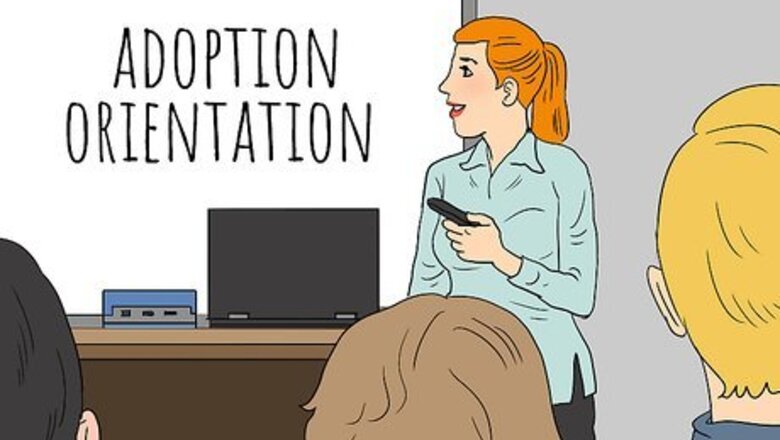
views
X
Research source
Going through a Public Agency
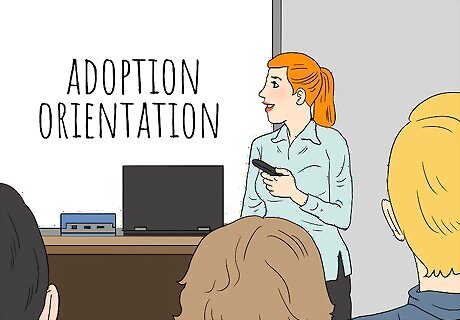
Attend an adoption orientation session. If you're thinking about adopting a child in government custody through a public agency, the agency will schedule an orientation session with you and your spouse (if you're married). During the orientation session, you will learn more about the public adoption process and the types of children who are available. It's a good idea to do some research on your own before you attend the orientation session. Come armed with questions to ask to make sure public adoption is the right choice for you and your family.

Fill out your written application. If you decide after orientation that you want to go through with public adoption, the adoption practitioner will give you an application to fill out. On the application, you'll provide information about your household and finances. You'll also have the opportunity to list preferences you may have in terms of the type of children you are interested in adopting. The fewer restrictions you have, the more quickly the agency will potentially be able to match you with a child. If you want to adopt an infant, you'll typically need to go through a private agency. Infants seldom, if ever, come through the public system. When they do, the public agency typically attempts to place them directly with a relative.

Participate in your home study. Through the home study, the adoption practitioner assigned to your case evaluates your household to determine your suitability to adopt. This evaluation also determines the types of children that would be best suited to your home environment and parenting style. The home study process can take anywhere from 6 to 8 months and includes at least 4 interviews with you, your partner, and other adult family members. The adoption practitioner assesses your motivation to adopt, personality, skills and education, parenting beliefs, and personal background. During the home study process, the adoption practitioner will also review documents you provide with information about your employment, criminal background, education, training, community involvement, and household finances.Tip: The home study process may seem intimidating and intrusive. However, keep in mind that the purpose of this process is to match prospective adoptive parents with the best possible child for their home environment – not to try to exclude or disqualify you as an adoptive parent.
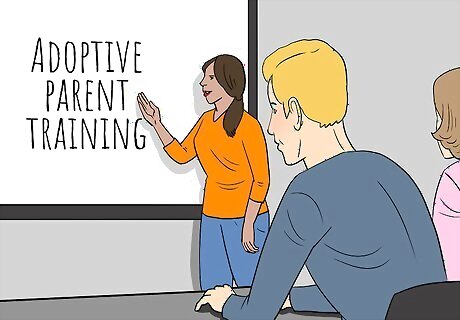
Take adoptive parent training courses. Many provinces and territories require prospective adoptive parents to complete training courses that teach you about the public adoption process and issues that adoptive children face. Courses may also include skills and techniques for parenting kids with special needs. For example, Ontario requires you to complete a standardized 27-hour program. These courses are free for prospective adoptive parents who've chosen public adoption.

Search for a matching child. After your home study report has been finalized, you'll meet with your adoption practitioner to go over the report and look at children available in the public system. Your adoption practitioner will work to match you with a child that's best suited for your household. Your province or territory will have directories and exchanges you can apply to be listed on. Being listed on these exchanges and directories may increase your chances of finding a match. With public adoption, you'll typically adopt a child who lives in your province or territory. While it is possible to adopt a child who lives in another province, you may have to go through an additional qualification process since some provinces are stricter than others.

Have a child placed in your home. How long it takes to find a match for your household depends on a number of factors, including your preferences and the number of children currently available in your territory or province. It may only take a few months, or it could take as long as a year. Once a matching child is found, you'll have several short-term visits with the child. If all goes well, the child will be placed in your home on a probationary basis. The probation period lasts at least 6 months. During this period, the adoption practitioner will visit your home frequently to make sure the placement is appropriate for your family and within the best needs of the child. Some of these visits may be scheduled, while others will be unannounced.
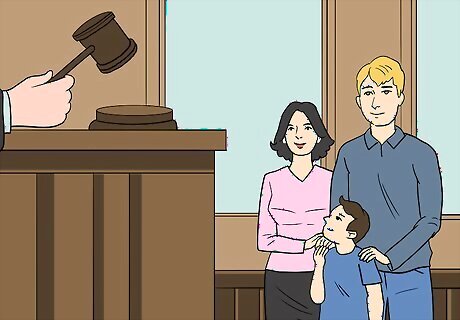
Finalize the adoption in a provincial court. Once the probation period is over, if your adoption practitioner determines that the match is a good fit for you and the adopted child, a petition will be filed in the nearest provincial court. After a brief hearing, the judge will issue an order finalizing the adoption. Adoption hearings typically are celebratory occasions. You can invite other family members to come and witness the adoption. Once you receive the order, you become the child's legal parent.Tip: If you adopt a child through a public agency, you may be eligible for financial assistance in caring for that child. Talk to your adoption practitioner after your adoption is finalized.
Using a Private Agency
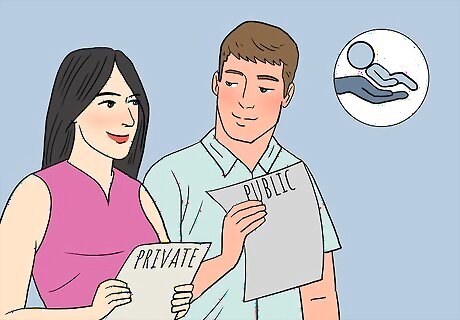
Compare private adoption to public adoption. Before you sign up with a private agency, make sure private adoption is the best option for you. Public adoption is generally free, while private domestic adoption can cost from $10,000 to $15,000, as of 2019. However, private adoption is generally the only way you can adopt a healthy Canadian infant. With a private adoption, you have a lot more control over the child that is placed in your home. You can also be more selective about your preferences. However, as with public adoptions, the more selective you are, the longer it may take for you to be matched with a child. If your biggest concern is your adopted baby's health, private adoption may be your best choice. You'll have the opportunity to carefully review the health history of the child's biological parents before deciding whether you want the child.Tip: Most private adoptions are open adoptions, meaning the birth mother (and potentially the birth father) will be a part of your life and your child's life. Before you decide to go with private adoption, make sure you're comfortable with the idea of your child having another set of parents.

Evaluate private agencies in your province or territory. There will likely be numerous private adoption agencies operating in your province or territory. It's a good idea to visit with 2 or 3 of them before you decide on the one you want. That way, you can choose the one where you feel the most comfortable, with fees that best suit your budget. The private agency you choose should be licensed to adopt children in your province or territory. The public adoption agency in your province or territory will have a list of licensed private agencies. You can typically access this list from the public agency's website. Contact private agencies you're interested in and schedule a meeting with their director to talk more about their adoption process.
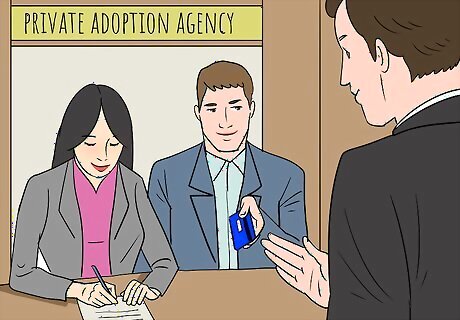
Apply as adoptive parents at a private agency. Your chosen agency will likely have a written application for you to fill out. On this application, you'll provide information about yourself and your household, your personal and educational background, your household finances, and your adoptive preferences. When you submit your application, you typically must pay an application fee of a few thousand dollars. Your adoption practitioner will provide you with a breakdown of the fees and when they are due. Much of the information you provide in your application will be verified through a home study. Your adoption practitioner will give you a list of documents you'll be expected to provide for the home study.

Have your home study completed. All provinces and territories require a home study before a child can be placed in your home for adoption. This process typically takes 6 to 8 months and involves multiple interviews with you and other family members, as well as a review of your personal and financial documents. Expect to pay a fee of $2,000 to $5,000 for completion of your home study. You may have to pay this fee separately or it may have been included with your application fee. Some provinces, such as Ontario, also require you to complete a parenting training program. You can complete this program while your home study is being completed.

Find a prospective mother who wants to place her child for adoption. Once your home study is completed, you'll be cleared to adopt a child. With a private agency, this typically involves writing an open letter to prospective mothers telling them a little about your household, your activities and interests. You'll also create a profile to submit to your agency. these materials will be available to prospective mothers. If someone is interested in placing their child with you, your agency will contact you. In some agencies, you are responsible for searching the listings. In others, the agency will search through listings and bring you potential matches based on your preferences and the preferences of the birth parents. This may also depend on the rules in your province or territory. When you find a potential match, you'll get information about the birth parents, including a medical background report and some personal information about them. This information can help you decide if you're interested in potentially adopting their baby.

Meet the birth mother and birth father. At most private agencies, this meeting is optional. However, private adoptions are typically open, meaning the birth mother (and potentially the birth father) will continue to have a role in your life and the life of your child. For this reason, if for no other, it's a good idea to meet the birth parents before the birth to see how well you get along with them. You may also have some questions for the birth parents that weren't answered through the background materials you were provided. A meeting gives you the opportunity to ask them. Meeting the birth parents in person also gives you a chance to observe their personalities and mannerisms. You can expect some of these traits to be passed to the child.

Have the infant placed in your home. If the birth parents agree to let you adopt their child, the infant will be brought to your home straight from the hospital. From that date, there is still a period during which the birth mother can revoke her consent to the adoption and raise the child as her own. This period varies among provinces and territories, but typically is around 30 days. For example, in Ontario, the birth mother cannot consent to adoption until the baby is 7 days old. After she consents, she has 21 days to change her mind and withdraw her consent. After the birth mother's revocation of consent period has expired, you'll have the baby for a probational period of around 6 months. During this time, your adoption practitioner will visit your home several times to see how things are going. Some of these visits will be scheduled, while some may be unannounced.

Finalize your adoption through the provincial ministry and court. Your adoption practitioner will make a recommendation at least 6 months after the baby has been placed in your home. Their report is reviewed by your adoption agency and the provincial or territorial ministry. If all approve, a petition is filed in provincial or territorial court to finalize the adoption. Typically, you will need to appear in court for a brief hearing before the judge enters an adoption order. Once the order is entered, you are the baby's legal parent.
Adopting a Child from Another Country

Contact the Central Adoption Authority in your province or territory. To locate the Central Adoption Authority in your province or territory, visit https://www.canada.ca/en/immigration-refugees-citizenship/services/canadians/adopt-child-abroad/authorities.html and scroll down until you see the name of the province or territory where you live. If you live in Québec, you must get authorization from the Secrétariat à l’adoption internationale before beginning the adoption process.
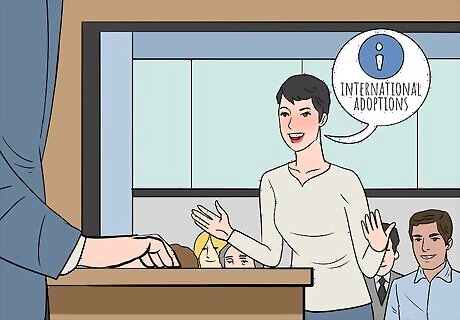
Attend information sessions at a private adoption agency. If you want to adopt a child from another country, you must use a private adoption agency. Look for private adoption agencies near you that specialize in international adoptions. The Central Adoption Authority in your province or territory will have information on agencies you can use. Different agencies may specialize in adopting children from specific countries. If you already have a country in mind that you want to adopt from, make sure you work with an agency that has connections in that country. It will make the process go more smoothly. At the information session, ask any questions you have about the agency's process, including how long the process will take and the fees that are charged.
Fill out the agency's written application. When you choose the agency you want to work with, they'll typically have you fill out a written application that provides them with basic information about your household, the reasons you want to adopt a child from another country, and your preferences regarding the child you want to adopt.
Based on this preliminary application, the agency can assess if they are able to help you and the fees that will be involved. The fees will likely differ depending on the countries you're interested in adopting from.Tip: Your choice of countries to adopt from may be limited depending on the characteristics of your household. Many countries only allow heterosexual couples to adopt and forbid single parents or same-sex couples.

Complete your home study and parent training. A home study and parent training are required for you to be approved as adoptive parents in Canada. The specific requirements for your home study and training are governed by the province or territory where you live. Some provinces may have more strict requirements than others. Expect your home study to take 6 to 8 months. After your home study is complete, a copy of the home study report will be sent to the Central Adoption Authority in your province or territory for approval.

Compile documents for your dossier. Once your home study and training are complete, your agency will work with you to get the documents you'll need for the dossier that will be sent to the country where you want to adopt. The specific documents required vary depending on the country you've chosen. Typically, you'll need educational transcripts, letters from your employers, references, financial documents, citizenship documents, and any applicable marriage certificates or divorce decrees. You may also need to complete a criminal background check. A copy of your home study report will also be included in your dossier. Many of the documents required by the other country may have already been submitted when you did your home study.

Submit your dossier to the adoption authorities in the child's country of origin. After your dossier is complete, your adoption agency will send it to the central adoption authority in the country where you want to adopt. You typically must pay a fee at this time which varies significantly depending on the country. Your adoption practitioner will provide you with a breakdown of the required fees and when you need to pay them. It can take several months for the central adoption authority in the other country to evaluate your dossier and approve it. Your adoption agency will notify you when you've been approved as prospective parents.
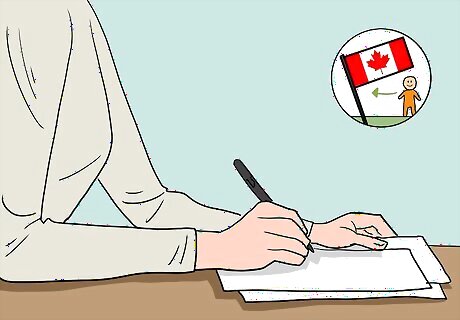
Fill out the immigration paperwork so the child can come to Canada. Once your dossier has been accepted and approved, you can start filling out the immigration paperwork so you can sponsor your child to come to Canada. To do so, you must be a Canadian citizen or permanent resident over 18 years of age who currently lives in Canada. Your adoption agency will have information on how to complete the paperwork for your child. You can start filling out the paperwork before you have information about a specific child.

Receive information about matches. The adoption authority in the other country will find a child for you based on the information in your dossier. You typically won't have much control over the child that is chosen, although typically they will try to find a child that most closely matches your preferences. The more selective your preferences are, the longer it will take for you to be matched with a child. When a match is found, a photo of the child with basic information about the child will be sent to your adoption agency. Your adoption agency will then share this information with you. Typically, you have a few days to think about whether you want to accept the match. In many countries, if you reject a match you are sent to the bottom of the queue of prospective parents, which can drastically increase the time it takes for you to get a child.
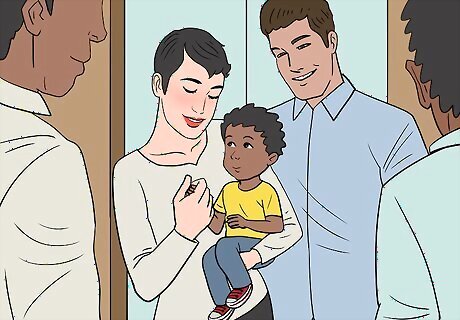
Travel to the child's country of origin to pick up your child. If you accept the match and the adoption is approved, you'll need to make arrangements to travel to the child's country of origin to finalize the adoption and bring your child back to Canada. The amount of time you'll spend in the child's country of origin depends on the country. In some countries, you'll have to complete courses on the culture and history of that country. Other countries may have several supervised visits with the child before the adoption is finally approved.
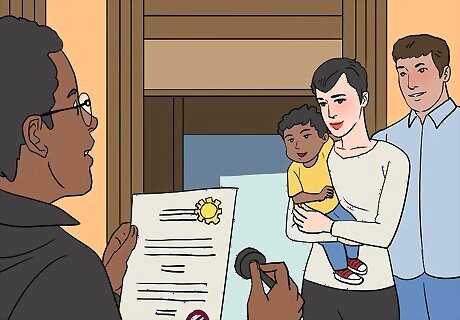
Finalize the adoption in the child's country of origin. In most countries, you'll appear in front of a judge in the child's country of origin to get an official adoption order from that country. Once the order is entered, the adoption is legal in that country, although it is still not yet completely final in Canada. In some countries, there may be a waiting period during which the child's birth mother can revoke her consent to the adoption. In that situation, you may need to remain in the child's country of origin until that period lapses. Your child cannot lawfully enter Canada unless the legal relationship between your adopted child and their adopted parents has ended.
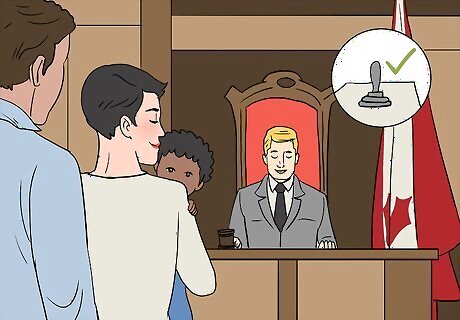
Get the child's adoption order and Canadian birth certificate from your provincial court. Once you're in Canada, your adoption agency will work with you to get an adoption order from the local court in your province or territory. You'll typically have to attend a brief hearing in the court before the order will be issued. When you return to Canada, your child will also need a medical exam before their permanent resident visa will be issued. Your adoption agency will explain when and where the exam will take place. Once the Canadian adoption order is entered and the Canadian birth certificate is issued, you are officially the legal parents of your child. At this point, your child can become a Canadian citizen.
Completing a Kinship Adoption
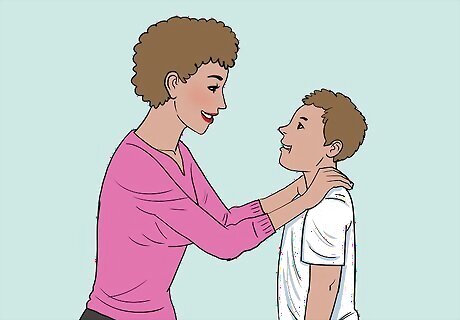
Confirm that you and the child qualify for relative adoption. The relative adoption process is significantly simpler than other adoption processes. However, to qualify, the child who you want to adopt must be your step-child, grandchild, niece or nephew, or great-niece or nephew. The child also must be a current legal resident of Canada. If you and the child are related in some other way, you must go through the private adoption process to adopt the child, including the completion of a home study and parenting training. For example, if you wanted to adopt your younger sibling, you would have to go through the private adoption process.Tip: If the relative child you want to adopt resides in another country, you must go through the full international adoption process. You can't use the shorter relative adoption process.

Hire an attorney to prepare and submit court documents. Relative adoptions can proceed directly through the courts without the need to work with an adoption agency or complete a home study or parenting training. Find a local family law attorney who specializes in kinship adoption to draft the paperwork for you. Adopting a related child still requires written consent from the child's current parents or legal guardians. For example, if you're adopting a step-child, you would need written consent from the child's noncustodial parent. If either of the child's parents is still living, they may need to relinquish their parental rights before the adoption can proceed.
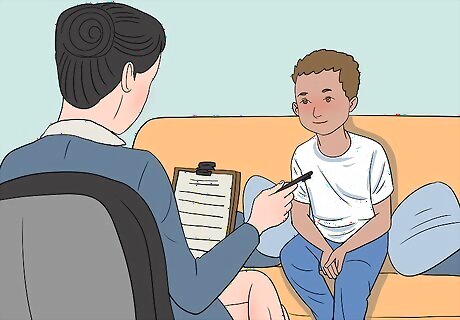
Have the child interviewed by a social worker. Children between the ages of 7 and 11 must be interviewed by a social worker, psychologist, or psychiatrist before the adoption takes place. If the child is over 12, they must sign a written consent to the adoption. For children 11 and under, the report created by the professional who interviewed them will be filed with the court and become a part of the case record. If you plan on changing the child's name and the child is over 12, they must also sign a written consent to the name change.
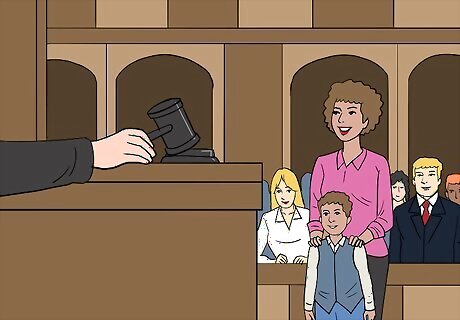
Attend your court hearing. Once all consents have been gathered and the child has been interviewed, the court will schedule a hearing to finalize the adoption. You and the child typically must appear in court for the adoption. An adoption hearing is typically considered a celebratory occasion and is relatively informal. Many adoptive parents invite friends and family members to come along and observe the ceremony. The judge may ask you and the child a few questions about the adoption, then they'll enter their order. Once the order is entered, you are the legal parent of the child.












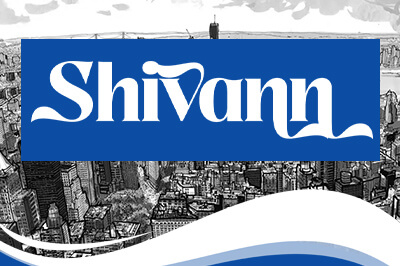


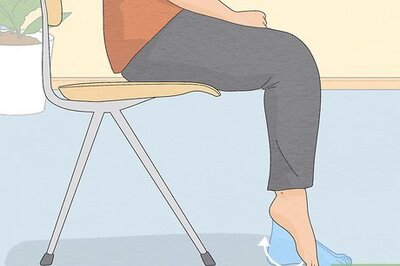
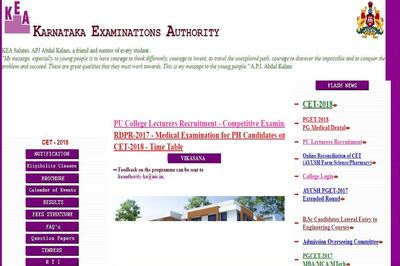


Comments
0 comment